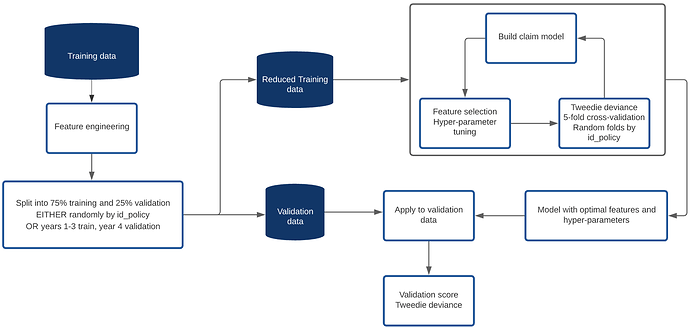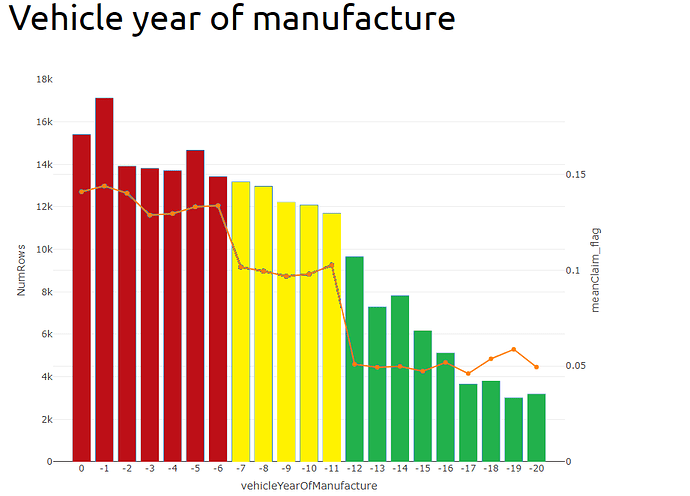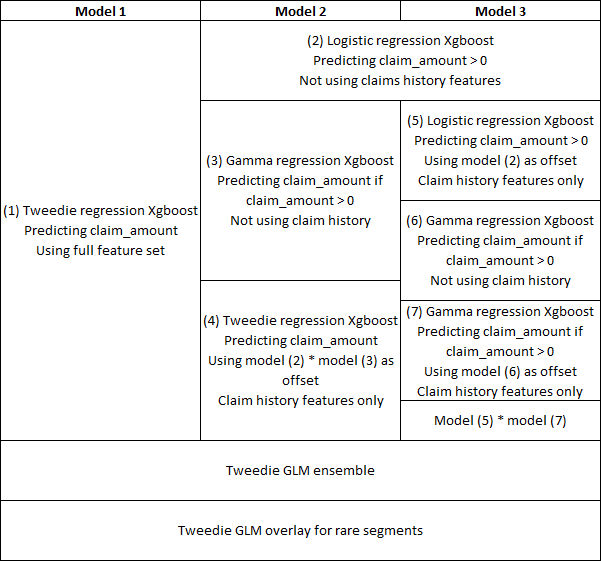Activity
Ratings Progression
Challenge Categories
Challenges Entered
Play in a realistic insurance market, compete for profit!
Latest submissions
See All| graded | 126410 | ||
| graded | 125457 | ||
| graded | 125333 |
A dataset and open-ended challenge for music recommendation research
Latest submissions
| Participant | Rating |
|---|
| Participant | Rating |
|---|
Insurance pricing game

1st place solution
Over 3 years agoCongratulations on the win! Thanks for open-sourcing, I am definitely going to have a look in detail at what you’ve done!!

3rd place solution
Over 3 years agoIt was very edifying to finish 3rd in this competition alongside some very strong competition.
My approach was to be as data-driven as possible and make extensive use of GBMs. I had a good validation strategy and I was very conservative about allowing small improvements to avoid hill-climbing my internal CV score. I biased my decision-making in favour of dropping features and applying monotonicity constraints where appropriate.
This was my model pipeline:
I coded up a lot of features but was strict about which ones actually were added to the models I built. Other than the raw features we were given, I included the following:
- Flag for locations with population < 20 or count < 4 (location defined as unique combination of population and town_surface_area)
- Count of location in training data
- Oldest and youngest driver ages, license lengths, sexes
- Vehicle momentum (speed * weight)
- Vehicle value adjusted for age of vehicle
- Count of vehicle
- Location target-value encoded features
- Vehicle target-value encoded features
- Vehicle year of manufacture (year - vh_age)
- NCD against par for age
- Age difference of drivers
- Features based on claims history and evolution of NCD for policies in the training data
I tested a lot more!
I said in my presentation that vehicle year of manufacture was my strongest variable. In fact, because I one-hot encoded pol_coverage into four variables, one for each level, when you re-combined their importances, pol_coverage was still the most predictive factor, but vehicle year of manufacture was not far behind and I got used to seeing it at the top of the list (and before I coded it, vh_age was top).
I was very surprised by how strong a predictor vehicle year of manufacture was. I don’t understand why vehicles manufactured in year -11 are twice as risky as vehicles manufactured one year before in year -12. I feel this must be some artefact of the way the data was put together - maybe it was extracted from three different sources and combined? I would be very interested to hear from the organisers as to why this factor should be as predictive as it was!
For dealing with year 5 pricing on policies where we had claims history, I augmented the training data by including each row twice, once with all the claims history set to missing, and once with the claims history features populated. (Technically I only included rows from year 1 once since either way there was no history). The features I used were, number of years with claims over the last n years, total amount claimed in the last n years, change in NCD over the last n years, etc.
I tried lots of different model structures and feature sets in the hope of getting a sharper final model by ensembing a range of diverse models. In the end, as I only used XGBoost, they tended not to be that diverse, or the ones that were diverse did not add much to the ensemble, of which only three made it.
My final structure is below:
I did not make many underwriting judgements or overlays but I did put in a discount for hybrid vehicles as the model was over-estimating the claims costs for them, I also had a discount where both drivers were female and loads where both were male as well as loads for quarterly payment frequency and pol_usage being “AllTrips”.
In the end I think I was probably very strong pricing policies that were in large homogeneous segments where there was plenty of data for xgboost to work its magic and potentially poor in areas where there were less data and more UW judgement might have been appropriate. I also don’t think I paid enough attention to the pricing element.
I tried to load my prices so that I was comfortably in profit, but also writing policies across the full range of premium values, from small to large.
On the whole it was a very rewarding experience and I enjoyed hearing how differently other people approached the same problem. In the end there were only a few teams that managed to write a significant market share while remaining profitable and I was very pleased to be among them.

Values in new heatmap changed between sunday and today?
Almost 4 years agoMine were split 50:50 between ‘often’ and ‘sometimes’ so there may have only been 2 or 4 large claims. Interesting to know if anyone had a lower resolution than 50% in that column.
Also… no team had a total profit larger than a single claim of max size, so there is obviously a lot of luck involved in the pricing leaderboard as well as the RMSE leaderboard.

My favorite submission from this week's leaderboard
Almost 4 years agoMy intuition is that the further up the leaderboard you look, the less correlated the RMSE score is with “model quality”, I.E. the ability of the model to generalise to new data. RMSE is more sensitive to the observations with large errors - in our case the rows with large claims - than many of the other model metrics that could have been chosen.
As an example, comparing these two dummy models using RMSE and MAE, the second model has more accurate predictions for 99.9% of the data and a better MAE, but worse predictions for the 0.1% of the data that has large claims and a worse RMSE.
.There is signal in how large claims are distributed of course, but they do tend to be quite random and noisy, so predicting the large claims in the leaderboard data well may not mean your model generalises well to other data sets.
For this reason, the signal to noise ratio in the RMSE metric is likely to decrease rapidly the higher up the leaderboard you look. It’s also noteworthy that the teams at the top of the RMSE leaderboard have more submissions than average suggesting random noise is significant.
And you may also have teams (like theworst?) that are building loads for profit into their claims predictions which will also lead to an uncoupling of the RMSE metric with the results from pricing.

What's in the test data?
Almost 4 years agoAre we allowed to know the proportion of test rows that are id_policy values that are in the training set? I thought I read in one of the other threads that it was 60:40 in one direction or the other, but I can’t find that now and it’s not on the front page.

 GB
GB






3rd place solution
Over 3 years agoTo answer your question, yes they only differed by a very small (I.E. close to 1) multiplicative constant.
Regarding vehicle year of manufacture, the difference between the three groups identified is stark and very consistent when the data is cut randomly or by some other feature. It would not surprise me to learn that the policies with claims were sampled at different rates across the groups for some reason or if there is some other artificial reason behind it, particularly since the boundary points seem so clearly defined.